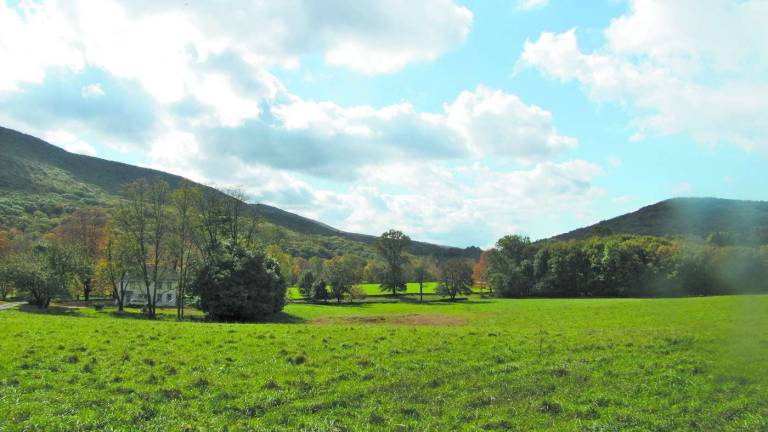Land trust helps towns manage open space New option: Towns retain open space ownership, leaving thorny issues to the land trust

CHESTER For years it was "Gimme shelter." Now it's "Gimme space."
The Chester Planning Board asked the Orange County Land Trust for help in monitoring undeveloped land. Public outcry against dense development in Orange County's rural areas have left behind many open acres that still need to be managed.
Planning experts say the best compromise is to build homes in clusters, or five-acre open area designs, which leave large portions of a subdivision undeveloped and available for recreation. But much of the open area offered by developers in their site plans is on steep slopes and in marshy areas, much of it useless for active recreation. Some towns have added the condition that open space offerings must be "usable."
The controversy continues. Some developers say buyers often prefer wetlands and steep slopes that offer fishing and pretty views.
The land trust steps in The Orange County Land Trust was created in 1993 to help with such quandaries. Through donations, covenants, easements and work with other conservancies like the Open Space Institute, the Trust now monitors over 3,600 acres in Orange County and has a goal of overseeing 5,000 acres. They form legal agreements with landowners to protect land in perpetuity.
Easements can be custom-made. Should the land be used by the public, or just the owner or residents? Can it be mowed? Can it include a shed, or a barn? Can it be used for farming?
Horseback riding is usually precluded, but not always. ATVs are almost always prohibited. Signs may be posted to identify it as an Environmentally Sensitive Area.
The conditions carry over to any new owner. The easement holder must make sure the conditions are followed.
Who holds an easement? In recent years, local boards have taken to attaching any large parcel of open space to one of the lots in a development. This avoids the legal hassle of forming a homeowners association to monitor the space. Sometimes developments are only partially built, or the homeowners association dissolves. In these instances, if a serious violation occurs such as a pool or shed being erected in an environmentally protected area a neighbor will generally bring it to the town's attention.
Increasingly, however, these violations go unnoticed or unreported, pressuring towns to take responsibility for easements because they'll just have to follow up on them anyway. But donating the land to a conservancy presents towns with another option, freeing them of the time, legal responsibility, and cost involved in managing open space. Sometimes a state or national group will help buy land and then donate it to the conservancy.
When such an offer is made, the land trust sends a representative to research the parcel, take photos, and write the agreement. A representative will visit the parcel at least once a year. They usually do not take on projects less than 20 acres.
The land trust can also be called upon to monitor important archeological areas or historic resources, provide public access, and do ecological studies on environmentally sensitive recreation areas like the Wallkill River.
The cost of easements When taking over a parcel, the land trust asks for a donation ranging from $8,000 to $25,000 to support its land stewardship and legal defense fund. The donation may be paid by the owner, developer, or town. An owner or developer can also donate the parcel directly.
Chris Kenyon, director of stewardship and conservation for the land trust, told the Chester Planning Board about a new arrangement in which towns most recently in Ulster County retain ownership of preserved parcels but contract with the land trust to do the monitoring it's already expert in doing. The land trust also know how to deal with violations and file court suits.
"This is a home run, if the land trust will take it and the developer pays the land trust," said Chester Planning Board Chair Don Serotta.
Planning board member Don Serotta added: "If we want these conservation efforts to mean anything, we will have to do something to make it stick."
The future of open space Ideally, Kenyon said, towns will increasingly form conservation advisory committees. These organizations, found in many communities in Orange County, identify parcels likely to become available and make options known to the landowners. The trust also works with the county planning department and water authority, which often get early notice of large parcels that may be coming up for sale through foreclosures or changes in legal status.
Kenyon said the state's general obligations law limits the liability of landowners who allow use of their property. As long is there is no monetary exchange for the use, there is no "duty of care," he said, unless there is obvious negligence, such as a known danger the visitor is not warned about.
The downside is that the town loses property tax revenue on easements. But town Supervisor Steve Neuhaus said he was not overly concerned.
"Pat Hines and Dave Donovan didn't just fall off the turnip truck," he said, referring to the planning board's engineer and attorney. "They represent a lot of towns in the area."
Neuhaus said he prefers that the town be offered the first right of refusal. As a former land trust member, he said he knows the pitfalls these donations can present.
One 185-acre parcel currently being offered to the land trust by a private party is situated along Greycourt Road at the Chester-Blooming Grove border, almost adjacent to the Heritage Trail and along Route 17. This location would seem to have a lot to offer. But while a spur trail through wetlands might work in fall and summer, some said, for more than half of the year it is probably accessible only by boat.